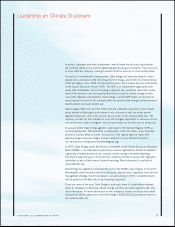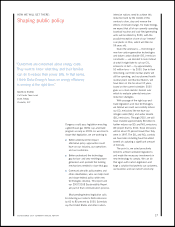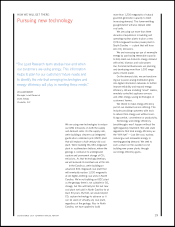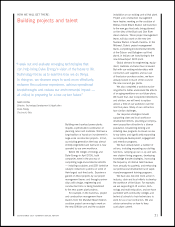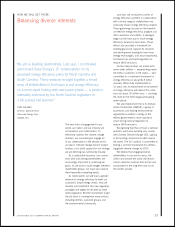Duke Energy 2007 Annual Report Download - page 21
Download and view the complete annual report
Please find page 21 of the 2007 Duke Energy annual report below. You can navigate through the pages in the report by either clicking on the pages listed below, or by using the keyword search tool below to find specific information within the annual report.
DUKE ENERGY 2007 SUMMARY ANNUAL REPORT 19
“The Load Research team studies how and when
our customers are using energy. This information
helps to plan for our customers’ future needs and
to identify the role that emerging technologies and
energy efficiency will play in meeting those needs.”
WILLIAM BAKER
Manager, Load Research
Duke Energy
Charlotte, N.C.
We are using new technologies to reduce
our GHG emissions on both the supply
and demand sides. On the supply side,
we’re building a cleaner-coal integrated
gasification combined cycle (IGCC) plant
that will replace a half-century-old coal
plant. We’re building this 630-megawatt
plant in southwestern Indiana, where the
geology is conducive to underground
capture and permanent storage of CO2
emissions. As that technology develops,
we will evaluate its eventual use at the site.
In the Carolinas, we’re building an
advanced 800-megawatt coal plant that
will eventually replace 1,000 megawatts
of old higher-emitting coal units in North
Carolina. We’re not building an IGCC plant
as the geology there is not suitable for CO2
storage, but this will likely be the last new
coal plant we build in North Carolina for at
least 20 years. By then, we would expect
CO2 capture technology to advance so it
can be used on virtually any coal plant,
regardless of the geology. Also in North
Carolina, we have applied to build
more than 1,200 megawatts of natural
gas-fired generation capacity to meet
increasing demand. This lower-emitting
gas generation will also replace older
coal units.
We are using our more than three
decades of experience in building and
operating nuclear plants to plan a new
2,234-megawatt nuclear power plant in
South Carolina — a plant that will have
zero CO2 emissions.
We are increasing our use of renewable
energy by purchasing renewable capacity
to help meet our domestic energy demand
with wind, biomass and solar power.
Our Commercial Businesses are planning
and developing more than 1,000 mega-
watts of wind power.
On the demand side, we are transform-
ing our passive analog distribution grids
into digital information networks to further
improve reliability and expand energy
efficiency. We are installing “smart” meters,
remotely controlled appliance sensors
and other energy-saving technologies in
customers’ homes.
We intend to make energy efficiency
part of our standard service offering. This
includes providing customers with tools
to reduce their energy use without sacri-
ficing comfort, convenience or productivity.
Technology and energy efficiency
breakthroughs won’t happen without the
right regulatory treatment. We seek state
regulations that treat energy efficiency as
the “fifth fuel” — just like coal, nuclear,
natural gas and renewable energy in
meeting growing demand. We seek to
earn a return on the avoided cost of
building new power plants through
our energy efficiency gains.
HOW WE WILL GET THERE:
Pursuing new technology


